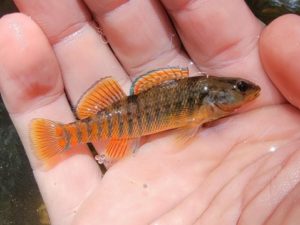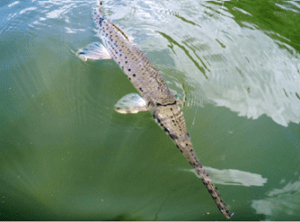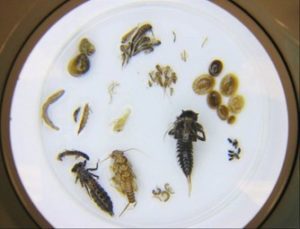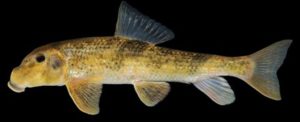Celebrating World Rivers Day
World Rivers Day takes place every year on the fourth Sunday of September and is a celebration of all the world’s waterways. Today, this holiday is an opportunity for us to reflect upon the importance of the many waterways found throughout Kentucky. A leisurely walk throughout The Parklands will illustrate the wide variety of life that depends on our waterway. The steady-flowing creek at the Sycamore Trail provides a home for many colorful native darter species as well as small schooling minnows. Within Pope Lick Park, many larger fish such as Longnose Gar can be found swimming throughout Floyds Fork. These animals represent only a handful of the 245 native fish found in Kentucky, all representing a crucial niche within our state’s aquatic ecosystem.

One of our most well-known of the native darters in Kentucky, the Rainbow Darter (Etheostoma caeruleum). Their colors of male darter species change dramatically during breeding season.

Longnose gar (Lepisosteus osseus) is the state’s most widespread species of gar. Feeding predominantly on other fishes, they are estimated to have been living in North American waterways for about 100 million years!
Fish of all shapes and sizes call Floyds Fork and its surrounding streams a home, but how can a relatively small waterway maintain a high level of biodiversity? To answer this question it is important to break the stream into two main components: abiotic factors and biotic factors. Abiotic factors refers to the nonliving components of a waterway. This would include characteristics such as temperature, water velocity, light, and oxygen concentration. Biotic factors refer to the living aspects of the stream such as the plants, animals, and microscopic life within the stream.
Floyds Fork consists of many microhabitats, allowing several different lifestyles to exist concurrently in our little waterway. Riffles, rocky areas where water velocity increases, are highly oxygenated areas that allow for macroinvertebrates and smaller fish to thrive. The presence of certain macroinvertebrates, such as stoneflies, mayflies, and water pennies, indicate high water quality due to their intolerance to pollution. Larger pools are also commonly found throughout Floyds Fork and serve as connections between smaller riffles. These areas, characterized by deeper and calmer waters, are home to the larger fishes of the stream. Fish that found themselves at the top of the food chain inside a riffle often find themselves as targets for the larger individuals within pools. Large bass and catfish lurk in the shadows within pools hunting for their next meal, and if the fish who call riffles home aren’t careful, they may find themselves on the menu along with many other aquatic critters.

Pictured are a few of the common aquatic macroinvertebrate species used for stream health analyses!
While there’s too many aquatic animals that call Kentucky waterways home to name here, exploring and researching your local waterways is a great way to get started! Flipping through a field guide and examining the differences in appearance of all our native fish species is a great way to get an introductory look at local aquatic biodiversity. The order of minnows and suckers, or Cypriniformes, shows that although some fish may be considered to be close relatives, they can look drastically different from one another. Within this order are many of our native minnow species. These fish often exhibit only minute morphological differences from one another and are considered difficult to accurately identify using a field guide. However, within the same order of fish, are one of my favorite and a downright silly looking fish, the Northern Hog Sucker. These fish are bottom dwellers that sift through the substrate searching for aquatic invertebrates and are always sure to get a few giggles from any visiting students that are lucky enough to observe one.

The Northern Hog Sucker, Hypentelium nigricans, can grow up to 2 ft. in length
With so many creatures that call Floyds Fork home, it’s easy to see why celebrating and protecting our waterways is vital to our environment and future. Take some time this weekend to sit by some water, come see The Parklands and Floyds Fork, and celebrate all the ways it has made an impact in your life. Splash around, examine any aquatic friends you may come across, and, as always, remember to keep it clean and be good stewards of our local waterways! Happy World Rivers Day!
